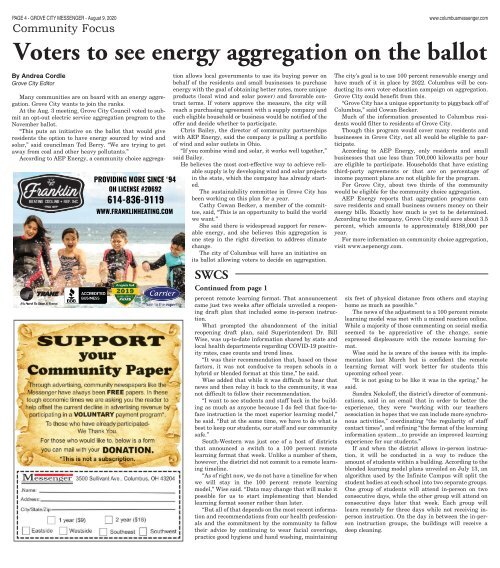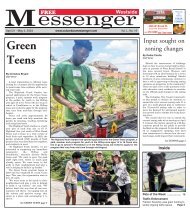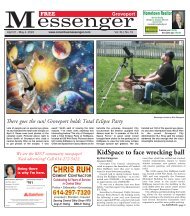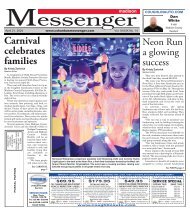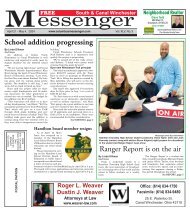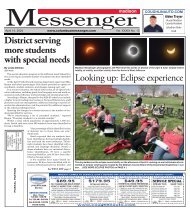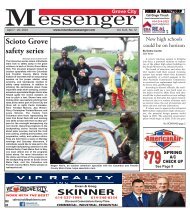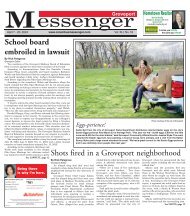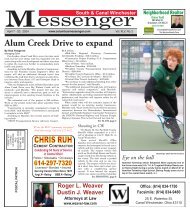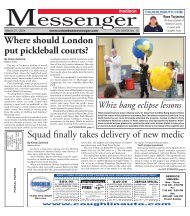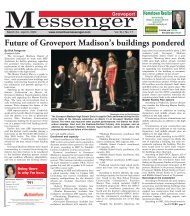Grove City Messenger - August 9th, 2020
Create successful ePaper yourself
Turn your PDF publications into a flip-book with our unique Google optimized e-Paper software.
PAGE 4 - GROVE CITY MESSENGER - <strong>August</strong> 9, <strong>2020</strong><br />
Community Focus<br />
www.columbusmessenger.com<br />
Voters to see energy aggregation on the ballot<br />
By Andrea Cordle<br />
<strong>Grove</strong> <strong>City</strong> Editor<br />
Many communities are on board with an energy aggregation.<br />
<strong>Grove</strong> <strong>City</strong> wants to join the ranks.<br />
At the Aug. 3 meeting, <strong>Grove</strong> <strong>City</strong> Council voted to submit<br />
an opt-out electric service aggregation program to the<br />
November ballot.<br />
“This puts an initiative on the ballot that would give<br />
residents the option to have energy sourced by wind and<br />
solar,” said councilman Ted Berry. “We are trying to get<br />
away from coal and other heavy pollutants.”<br />
According to AEP Energy, a community choice aggregation<br />
allows local governments to use its buying power on<br />
behalf of the residents and small businesses to purchase<br />
energy with the goal of obtaining better rates, more unique<br />
products (local wind and solar power) and favorable contract<br />
terms. If voters approve the measure, the city will<br />
reach a purchasing agreement with a supply company and<br />
each eligible household or business would be notified of the<br />
offer and decide whether to participate.<br />
Chris Bailey, the director of community partnerships<br />
with AEP Energy, said the company is pulling a portfolio<br />
of wind and solar outlets in Ohio.<br />
“If you combine wind and solar, it works well together,”<br />
said Bailey.<br />
He believes the most cost-effective way to achieve reliable<br />
supply is by developing wind and solar projects<br />
in the state, which the company has already started.<br />
The sustainability committee in <strong>Grove</strong> <strong>City</strong> has<br />
been working on this plan for a year.<br />
Cathy Cowan Becker, a member of the committee,<br />
said, “This is an opportunity to build the world<br />
we want.”<br />
She said there is widespread support for renewable<br />
energy, and she believes this aggregation is<br />
one step in the right direction to address climate<br />
change.<br />
The city of Columbus will have an initiative on<br />
its ballot allowing voters to decide on aggregation.<br />
SWCS<br />
Continued from page 1<br />
percent remote learning format. That announcement<br />
came just two weeks after officials unveiled a reopening<br />
draft plan that included some in-person instruction.<br />
What prompted the abandonment of the initial<br />
reopening draft plan, said Superintendent Dr. Bill<br />
Wise, was up-to-date information shared by state and<br />
local health departments regarding COVID-19 positivity<br />
rates, case counts and trend lines.<br />
“It was their recommendation that, based on these<br />
factors, it was not conducive to reopen schools in a<br />
hybrid or blended format at this time,” he said.<br />
Wise added that while it was difficult to hear that<br />
news and then relay it back to the community, it was<br />
not difficult to follow their recommendation.<br />
“I want to see students and staff back in the building<br />
as much as anyone because I do feel that face-toface<br />
instruction is the most superior learning model,”<br />
he said. “But at the same time, we have to do what is<br />
best to keep our students, our staff and our community<br />
safe.”<br />
South-Western was just one of a host of districts<br />
that announced a switch to a 100 percent remote<br />
learning format that week. Unlike a number of them,<br />
however, the district did not commit to a remote learning<br />
timeline.<br />
“As of right now, we do not have a timeline for when<br />
we will stay in the 100 percent remote learning<br />
model,” Wise said. “Data may change that will make it<br />
possible for us to start implementing that blended<br />
learning format sooner rather than later.<br />
“But all of that depends on the most recent information<br />
and recommendations from our health professionals<br />
and the commitment by the community to follow<br />
their advice by continuing to wear facial coverings,<br />
practice good hygiene and hand washing, maintaining<br />
The city’s goal is to use 100 percent renewable energy and<br />
have much of it in place by 2022. Columbus will be conducting<br />
its own voter education campaign on aggregation.<br />
<strong>Grove</strong> <strong>City</strong> could benefit from this.<br />
“<strong>Grove</strong> <strong>City</strong> has a unique opportunity to piggyback off of<br />
Columbus,” said Cowan Becker.<br />
Much of the information presented to Columbus residents<br />
would filter to residents of <strong>Grove</strong> <strong>City</strong>.<br />
Though this program would cover many residents and<br />
businesses in <strong>Grove</strong> <strong>City</strong>, not all would be eligible to participate.<br />
According to AEP Energy, only residents and small<br />
businesses that use less than 700,000 kilowatts per hour<br />
are eligible to participate. Households that have existing<br />
third-party agreements or that are on percentage of<br />
income payment plans are not eligible for the program.<br />
For <strong>Grove</strong> <strong>City</strong>, about two thirds of the community<br />
would be eligible for the community choice aggregation.<br />
AEP Energy reports that aggregation programs can<br />
save residents and small business owners money on their<br />
energy bills. Exactly how much is yet to be determined.<br />
According to the company, <strong>Grove</strong> <strong>City</strong> could save about 3.5<br />
percent, which amounts to approximately $188,000 per<br />
year.<br />
For more information on community choice aggregation,<br />
visit www.aepenergy.com.<br />
six feet of physical distance from others and staying<br />
home as much as possible.”<br />
The news of the adjustment to a 100 percent remote<br />
learning model was met with a mixed reaction online.<br />
While a majority of those commenting on social media<br />
seemed to be appreciative of the change, some<br />
expressed displeasure with the remote learning format.<br />
Wise said he is aware of the issues with its implementation<br />
last March but is confident the remote<br />
learning format will work better for students this<br />
upcoming school year.<br />
“It is not going to be like it was in the spring,” he<br />
said.<br />
Sandra Nekoloff, the district’s director of communications,<br />
said in an email that in order to better the<br />
experience, they were “working with our teachers<br />
association in hopes that we can include more synchronous<br />
activities,” coordinating “the regularity of staff<br />
contact times”, and refining “the format of the learning<br />
information system…to provide an improved learning<br />
experience for our students.”<br />
If and when the district allows in-person instruction,<br />
it will be conducted in a way to reduce the<br />
amount of students within a building. According to the<br />
blended learning model plans unveiled on July 13, an<br />
algorithm used by the Infinite Campus will split the<br />
student bodies at each school into two separate groups.<br />
One group of students will attend in-person on two<br />
consecutive days, while the other group will attend on<br />
consecutive days later that week. Each group will<br />
learn remotely for three days while not receiving inperson<br />
instruction. On the day in between the in-person<br />
instruction groups, the buildings will receive a<br />
deep cleaning.


